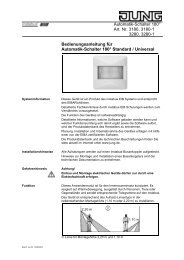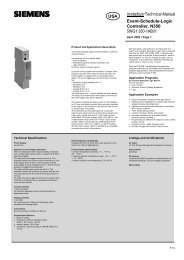Create successful ePaper yourself
Turn your PDF publications into a flip-book with our unique Google optimized e-Paper software.
4.2.4.12.4 Alarms<br />
Activating and deactivating an alarm<br />
If a detector within an armed area responds, or a sabotage detector triggers when armed or any<br />
detector is found to be missing, the signalling system switches to the "Alarm" status and activates<br />
the internal siren and, with additional external arming, also the visual alarm. For this, "1"<br />
telegrams are transmitted to the bus using the corresponding 1 bit communication objects. In<br />
addition, the panel transmits a "1" telegram via the "Alarm" object. This allows any switching<br />
function to be executed in the bus. In addition, the signalling system uses the<br />
14 byte object "Alarm detector text" to display the detector text of the detector which triggered<br />
the alarm.<br />
The internal siren is an alarm encoder activated for a set period of time. The system project<br />
planner must set the switching length of the internal siren in the ETS plug-in. Switching times of<br />
2 s to 255 s are possible. The signalling system automatically deactivates the internal siren<br />
when the switching time after the alarm is triggered has elapsed. The visual alarm (e.g. a flashing<br />
light on the exterior of the building) remains activated for the entire length of the alarm status<br />
(see "Alarm acknowledgement" section below).<br />
An alarm and the detector causing it are logged in the event memory of the panel (see chapter<br />
4.2.4.12.6. Event memory).<br />
An active alarm can be switched off by unarming on the panel or using a KNX/EIB switching<br />
unit. In this case, the panel switches the internal siren off if it has not already been switched off<br />
automatically after a period of time has elapsed, transmits a "0" telegram to the bus via the<br />
"Alarm" object and switches to the status "Unarmed after alarm". The visual alarm (for external<br />
alarming) remains switched on.<br />
i In the case of an alarm, the panel can also send an e-mail with a predefined text, providing<br />
that the Ethernet functionality of the panel is used and an e-mail mailbox was configured.<br />
For this, the "Alarm" object of the signalling system can be linked to the<br />
"Send e-mail" object of an event e-mail of the panel using an internal or external group address<br />
(see chapter 4.2.4.13.1. Introduction).<br />
Alarm delay / Prealarm<br />
An alarm delay can optionally be configured for internal and external alarm. An alarm delay is<br />
often used when the switching device (e.g. the panel or a button sensor) is installed in the secure<br />
area of the building. In such cases, authorised people must be able to enter the secured<br />
building area, meaning the status the switching device for unarming can only be reached after a<br />
delay.<br />
The alarm delay can be configured separately, using the parameter of the same name in the<br />
ETS plug-in, for internal and external arming. Delay times of 0 s to 255 s can be configured. The<br />
setting "0 s" (presetting) deactivates the alarm delay for the appropriate arming operation.<br />
If an alarm delay time is running during system operation, a "Prealarm" can be activated first.<br />
Depending on the parameter configuration, a prealarm is signalled by the piezo buzzer of the<br />
panel and/or separate 1 bit communication objects. During a prealarm, an authorised person<br />
can unarm the system without triggering a 'real' alarm. The transition to the "Alarm" status only<br />
takes place is the system is not unarmed during the prealarm.<br />
i A prealarm configured in the ETS plug-in only functions if an alarm delay time of more than<br />
0 s has been configured. Otherwise the prealarm will not be executed during system operation.<br />
i An alarm due to a triggered sabotage detector or a missing detector is always executed<br />
without delay.<br />
Order-No. 7574 00 1X<br />
Software "...590101"<br />
Functional description<br />
Page 122 of 222

















